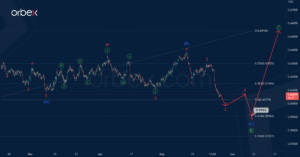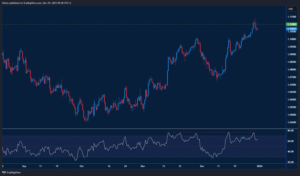There is a trove of data from the UK coming out this week, with two key data points that could be pivotal for determining how much the BOE will hike at its next meeting. After the GDP figures reported last week were better than expected, the consensus is firmly in the camp of more rate hikes. But whether or not 50bps is back on the table, or the BOE might communicate a less aggressive stance moving forward, is down to the CPI figures.
UK’s preliminary Q2 GDP data pointed to a bright spot for the economy: Household spending remained resilient despite the cost-of-living crisis. Part of that could be due to something that is proving to be a major headache for the BOE, and making the UK an outlier among major economies. Wages in the UK have been rising substantially faster than in other countries. Albeit, inflation has been rising even faster.
The employment problem for the BOE
With the unemployment level hovering below the structural level, UK workers have managed to secure strong salary increases over the last year. According to the consensus of economists, average wages increased 7.1% annually in July. This has helped maintain consumer demand and leave the economy growing. But, it also fuels prices staying high. In effect, it’s a milder version of the wage-price spiral that central bankers fear. Running at around triple the target rate, it will take effort and careful action by the BOE to get prices down without tipping the economy into a recession.
That’s why many traders might be looking for signs that the labor market might be “cracking”. If unemployment or claimant count rise substantially, it could mean that wage pressures could abate in the future. Although this would likely imply slow economic progress for a while, it could mean the BOE is about to give up on the rate hikes. But, if the contrary were to happen, then it could be seen as a sign that the BOE will have to keep tightening. And with inflation expected to finally fall under the jobs numbers, that could end up substantially supporting the pound.
What the data says
On Tuesday, the ONS will report labor figures, with the unemployment rate expected to remain steady at 4.0%. The claimant count number is expected to be -30K, wiping out the +25.7K reported in the prior month. It’s worth remembering that the lower the claimant count is, generally speaking, the better it is for the pound. A negative number means that fewer people than in the prior month have lost their jobs, and required unemployment assistance.
On Wednesday, the UK is expected to see the headline inflation rate come down to 6.9% from 7.9% prior. A part of that substantial drop is expected to be from base effects, as last July saw a large increase in fuel costs. Monthly inflation is expected to be -0.3% compared to 0.1% previously. The lower inflation would help increase the real yield on UK debt, making the pound more attractive for investors.
The next rate decision
What will likely define the reaction to the pound, however, is the core rate, which is expected to tick down to 6.8% from 6.9% prior. This is the figure most focused on by the BOE, since it removes the volatile elements of fuel and food costs. BOE Governor Bailey has warned in the past that inflation effects were already moving beyond consumer prices and were becoming entrenched with the rising cost of labor.
Unless there is a surprise with the core rate coming down, the BOE will likely feel obligated to keep tightening to bring down prices. Particularly if the labor market remains tight. If the core rate surprises to the upside by just two decimals, it would signal a potential reverse in the trend, which could bring investor bets back that the BOE might go so far as to hike by 50bps at the next meeting.
Trading the news requires access to extensive market research - and that's what we do best.
- SEO Powered Content & PR Distribution. Get Amplified Today.
- PlatoData.Network Vertical Generative Ai. Empower Yourself. Access Here.
- PlatoAiStream. Web3 Intelligence. Knowledge Amplified. Access Here.
- PlatoESG. Automotive / EVs, Carbon, CleanTech, Energy, Environment, Solar, Waste Management. Access Here.
- PlatoHealth. Biotech and Clinical Trials Intelligence. Access Here.
- ChartPrime. Elevate your Trading Game with ChartPrime. Access Here.
- BlockOffsets. Modernizing Environmental Offset Ownership. Access Here.
- Source: https://www.orbex.com/blog/en/2023/08/uk-jobs-cpi-figures-to-define-boe-hike
- :has
- :is
- :not
- $UP
- 50bps
- 7
- a
- About
- access
- According
- Action
- After
- aggressive
- already
- also
- Although
- among
- an
- and
- Annually
- app
- around
- AS
- Assistance
- At
- attractive
- average
- back
- BAILeY
- bankers
- base
- BE
- becoming
- been
- below
- BEST
- Bets
- Better
- Beyond
- Blog
- BoE
- BoE Governor Bailey
- Bright
- bring
- but
- by
- Camp
- careful
- central
- central bankers
- come
- coming
- communicate
- compared
- Consensus
- consumer
- contrary
- Core
- Cost
- Costs
- could
- countries
- CPI
- crisis
- data
- data points
- Debt
- Demand
- Despite
- determining
- do
- down
- Drop
- due
- Economic
- economies
- economists
- economy
- effect
- effects
- effort
- elements
- employment
- end
- entrenched
- Ether (ETH)
- Even
- expected
- extensive
- Fall
- far
- faster
- fear
- feel
- fewer
- Figure
- Figures
- Finally
- firmly
- focused
- food
- For
- For Investors
- forex
- Forex Trading
- Forward
- from
- Fuel
- fuels
- future
- GDP
- generally
- get
- Give
- Go
- Governor
- Growing
- happen
- Have
- headline
- help
- helped
- High
- Hike
- Hikes
- household
- How
- However
- HTTPS
- if
- image
- in
- In other
- Increase
- increased
- Increases
- inflation
- inflation rate
- into
- investor
- Investors
- IT
- ITS
- Jobs
- July
- just
- Keep
- Key
- labor
- labor market
- large
- Last
- Last Year
- Leave
- less
- Level
- likely
- live
- looking
- lost
- lower
- maintain
- major
- Making
- managed
- many
- Market
- market research
- mean
- means
- meeting
- might
- Mobile
- Mobile app
- Month
- monthly
- more
- most
- moving
- much
- negative
- news
- next
- number
- numbers
- of
- on
- or
- Other
- out
- over
- part
- particularly
- past
- People
- pivotal
- plato
- Plato Data Intelligence
- PlatoData
- points
- potential
- pound
- previously
- Prices
- Prior
- Problem
- Progress
- Q2
- Rate
- rate hikes
- reaction
- real
- Real Yield
- recession
- remain
- remained
- remains
- remembering
- report
- Reported
- required
- requires
- research
- resilient
- reverse
- Rise
- rising
- running
- s
- salary
- saw
- secure
- see
- seen
- sign
- Signal
- Signs
- since
- slow
- So
- so Far
- something
- speaking
- Spending
- Spot
- steady
- strong
- structural
- substantial
- substantially
- Supporting
- surprise
- surprises
- table
- Take
- Target
- than
- that
- The
- The Future
- the UK
- their
- then
- There.
- this
- this week
- tightening
- Tipping
- to
- Traders
- Trading
- Trend
- Triple
- Tuesday
- two
- Uk
- under
- unemployment
- unemployment rate
- Upside
- URL
- version
- volatile
- wage
- wages
- we
- Wednesday
- week
- were
- What
- whether
- which
- while
- why
- will
- wiping
- with
- without
- workers
- worth
- would
- year
- Yield
- zephyrnet













